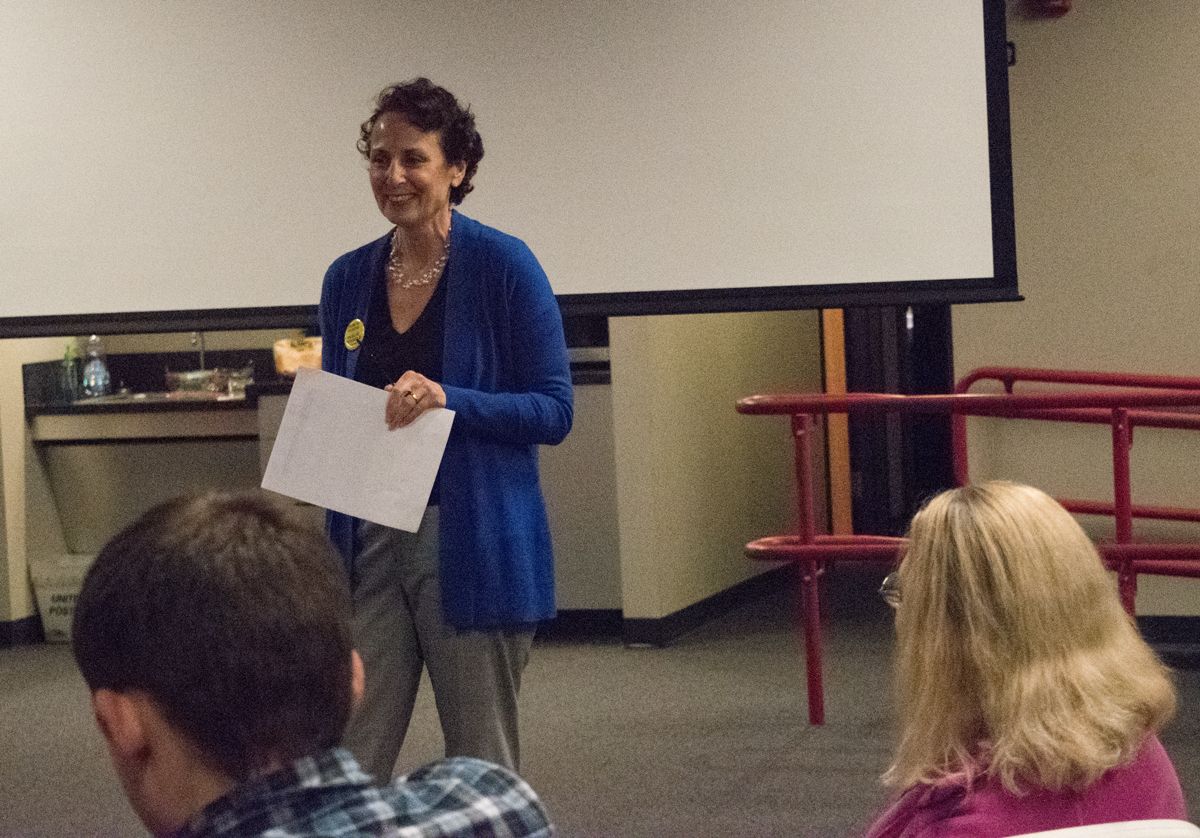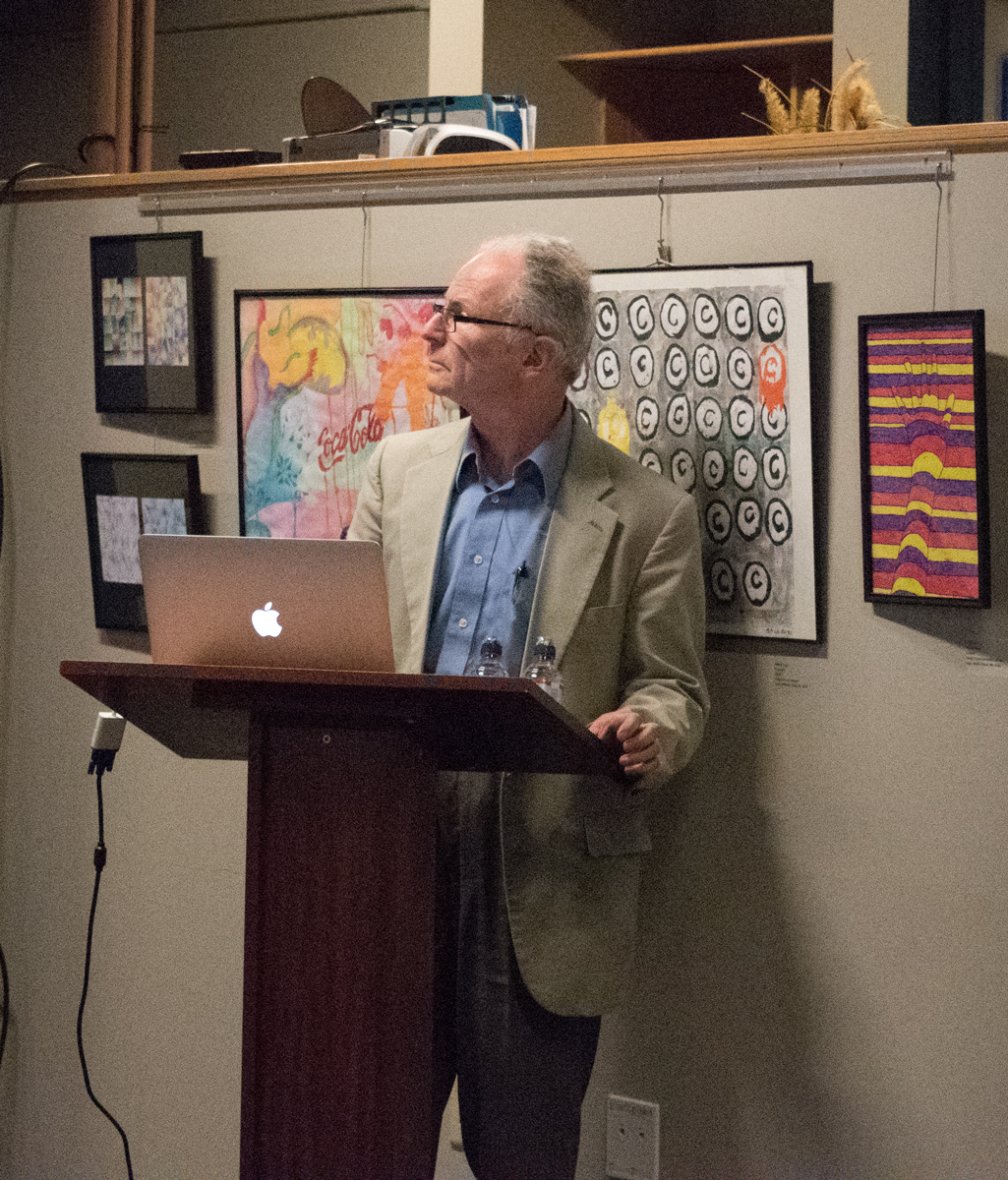 Driven by an $18 million advertising campaign, those in favor of lifting the current cap on charter school seats have launched an all-out effort to increase the number of seats allocated to charter schools. This ballot initiative is one of several state-driven mandates, ruling, issues - whatever you choose to call them - that is spurring Lowellians to become more vocal advocates for our Lowell Public Schools.Last Tuesday, Lisa Guisbond (Executive Director) and Alain Jehlen of Citizens for Public Schools led a discussion and information session about about the impact of not only this ballot question, but other state education policies as well. Should it be successful, the "lift the cap" ballot initiative has the potential of transferring funding away from the Lowell Public Schools. Why does this matter to Lowell and what impact would increasing seats have on school programs and budgets?Lisa Guisbond began the session by giving an overview of how and why charter schools began. Starting with their inception in 1993, publicly funded charter schools have morphed over the last 20-plus years from schools set up to try to impact learning through innovation to schools often times managed by corporations. In Lowell, we have both models of charter schools - one run independently and another set up as a SABIS school.While Commonwealth Charter Schools are set up as chartered public schools and receive funding from the local community, there are several concerns. Accountability to the local community and demographics of the student body which often does not represent the traditional public school student body are among two of many concerns.Most communities have a limit of 9% of the foundation enrollment on charter schools seats; however, some communities - and Lowell falls in this second category - are designated differently and the limit is 18% (double). Lowell currently has 9.2% of its student population attending Commonwealth charter schools so there is room for growth or even new schools to be chartered within the City. Lisa's presentation triggered discussions about who authorizes charter schools (the state Board of Education), the current Commissioner's role in monitoring, governance (appointed boards which do not include representation from the community's governing entities). Therefore unlike traditional public schools where the elected School Committee answers to the public on how public monies are spent or how school policy is overseen, Commonwealth Charter Schools, operate with appointed boards that do not answer to the public funding the school. As Lisa pointed out, there is a prevailing sense of pro-charter support by Governor Baker, Secretary of Education (James Peyser) and the Board of Education, all of whom have had or currently have some connection to Charter Schools through their participation in and/or connections to Charter Schools.Alain Jehlen, a Somerville resident and member of Citizens for Public Schools, presented
Driven by an $18 million advertising campaign, those in favor of lifting the current cap on charter school seats have launched an all-out effort to increase the number of seats allocated to charter schools. This ballot initiative is one of several state-driven mandates, ruling, issues - whatever you choose to call them - that is spurring Lowellians to become more vocal advocates for our Lowell Public Schools.Last Tuesday, Lisa Guisbond (Executive Director) and Alain Jehlen of Citizens for Public Schools led a discussion and information session about about the impact of not only this ballot question, but other state education policies as well. Should it be successful, the "lift the cap" ballot initiative has the potential of transferring funding away from the Lowell Public Schools. Why does this matter to Lowell and what impact would increasing seats have on school programs and budgets?Lisa Guisbond began the session by giving an overview of how and why charter schools began. Starting with their inception in 1993, publicly funded charter schools have morphed over the last 20-plus years from schools set up to try to impact learning through innovation to schools often times managed by corporations. In Lowell, we have both models of charter schools - one run independently and another set up as a SABIS school.While Commonwealth Charter Schools are set up as chartered public schools and receive funding from the local community, there are several concerns. Accountability to the local community and demographics of the student body which often does not represent the traditional public school student body are among two of many concerns.Most communities have a limit of 9% of the foundation enrollment on charter schools seats; however, some communities - and Lowell falls in this second category - are designated differently and the limit is 18% (double). Lowell currently has 9.2% of its student population attending Commonwealth charter schools so there is room for growth or even new schools to be chartered within the City. Lisa's presentation triggered discussions about who authorizes charter schools (the state Board of Education), the current Commissioner's role in monitoring, governance (appointed boards which do not include representation from the community's governing entities). Therefore unlike traditional public schools where the elected School Committee answers to the public on how public monies are spent or how school policy is overseen, Commonwealth Charter Schools, operate with appointed boards that do not answer to the public funding the school. As Lisa pointed out, there is a prevailing sense of pro-charter support by Governor Baker, Secretary of Education (James Peyser) and the Board of Education, all of whom have had or currently have some connection to Charter Schools through their participation in and/or connections to Charter Schools.Alain Jehlen, a Somerville resident and member of Citizens for Public Schools, presented  information regarding how local funding is allocated to charter schools within a district and pointed out that our very own Commonwealth does not always fund (in fact almost never) the state budget adequately to provide the legislated reimbursement to municipal budgets. The trickle down effect of the under-funding is that traditional public school budgets and/or municipalities make up the gap in funds through their own budgets.Thinking about Lowell's budget this current year, about $17 million was paid to charter schools for Lowell students and approximately $3 million was reimbursed by the Commonwealth. That $3 million was about $1.3 million short of the state's responsibility. When there is a shortfall in the reimbursement funding, the local community must fill the gap between assessed amount and state reimbursement. In other words, a traditional public school program might need to be cut or a municipal service eliminated. Cities and towns often find themselves making difficult financial decisions because the Commonwealth does not live up to its promises.According to the DESE website, Lowell's 2016-17 assessment will be based on 1,494 students enrolled in charter schools (15,300 in traditional public schools) which represents 9.8% of the foundation enrollment. A District payment of $18,430,028 will be assessed with the mythical reimbursement of $3,708,525 from the Commonwealth IF charter reimbursements are fully funded in the state budget. And if not.... well Lowell, already tightening fiscal belts and consolidating programs, will need to find the difference somewhere in the City's budget.The Q&A session from the group continued discussion about the impact of the ballot initiative fiscally and educationally. Several raised concerns about increasing charter seats and how that might impact the proposed budget for next fiscal year. There was some surprise to learn that if a student is counted as enrolled in a charter school on October 1, but leaves to return to the city's public schools after that, the per pupil funding stays at the charter school until the next school year.There was interest in continuing informational discussions in the near future.If you, or someone you know would like to continue to be informed about this issue, we invite you to email the local group at lowellcps@gmail.com to be added to the email list. Additional information about Citizens for Public Schools and their advocacy efforts can be found on either their Facebook page or on the web at http://www.citizensforpublicschools.org.
information regarding how local funding is allocated to charter schools within a district and pointed out that our very own Commonwealth does not always fund (in fact almost never) the state budget adequately to provide the legislated reimbursement to municipal budgets. The trickle down effect of the under-funding is that traditional public school budgets and/or municipalities make up the gap in funds through their own budgets.Thinking about Lowell's budget this current year, about $17 million was paid to charter schools for Lowell students and approximately $3 million was reimbursed by the Commonwealth. That $3 million was about $1.3 million short of the state's responsibility. When there is a shortfall in the reimbursement funding, the local community must fill the gap between assessed amount and state reimbursement. In other words, a traditional public school program might need to be cut or a municipal service eliminated. Cities and towns often find themselves making difficult financial decisions because the Commonwealth does not live up to its promises.According to the DESE website, Lowell's 2016-17 assessment will be based on 1,494 students enrolled in charter schools (15,300 in traditional public schools) which represents 9.8% of the foundation enrollment. A District payment of $18,430,028 will be assessed with the mythical reimbursement of $3,708,525 from the Commonwealth IF charter reimbursements are fully funded in the state budget. And if not.... well Lowell, already tightening fiscal belts and consolidating programs, will need to find the difference somewhere in the City's budget.The Q&A session from the group continued discussion about the impact of the ballot initiative fiscally and educationally. Several raised concerns about increasing charter seats and how that might impact the proposed budget for next fiscal year. There was some surprise to learn that if a student is counted as enrolled in a charter school on October 1, but leaves to return to the city's public schools after that, the per pupil funding stays at the charter school until the next school year.There was interest in continuing informational discussions in the near future.If you, or someone you know would like to continue to be informed about this issue, we invite you to email the local group at lowellcps@gmail.com to be added to the email list. Additional information about Citizens for Public Schools and their advocacy efforts can be found on either their Facebook page or on the web at http://www.citizensforpublicschools.org.
 Day four's Meditation from the Mat really resonated with me. That is so not only because of the simple truth, but also because what happens on a daily - or is it hourly - basis in these unprecedented times calls us to do something.When legislative leaders in the United States can't find money to fund the Children's Health Insurance Program (CHIP), but can find a (very) sizeable tax give-away to very rich and powerful donors, it is time to act.When the Congress of the United States entertains an offset to the deficits that will result from said give-aways by reducing Medicare and Social Security benefits, it is time to act.When state aid to schools is based upon 24 year old (plus) formulas that result in underfunded public schools, it is time to act.When our unique differences are a flashpoint for senseless violence and discrimination, it is time to act.We must act, we need to speak our truth when we witness or experience those things that harm not only our personal selves, but our collective self. Because we are the ones we've been waiting for.
Day four's Meditation from the Mat really resonated with me. That is so not only because of the simple truth, but also because what happens on a daily - or is it hourly - basis in these unprecedented times calls us to do something.When legislative leaders in the United States can't find money to fund the Children's Health Insurance Program (CHIP), but can find a (very) sizeable tax give-away to very rich and powerful donors, it is time to act.When the Congress of the United States entertains an offset to the deficits that will result from said give-aways by reducing Medicare and Social Security benefits, it is time to act.When state aid to schools is based upon 24 year old (plus) formulas that result in underfunded public schools, it is time to act.When our unique differences are a flashpoint for senseless violence and discrimination, it is time to act.We must act, we need to speak our truth when we witness or experience those things that harm not only our personal selves, but our collective self. Because we are the ones we've been waiting for.
 Driven by an $18 million advertising campaign, those in favor of lifting the current cap on charter school seats have launched an all-out effort to increase the number of seats allocated to charter schools. This
Driven by an $18 million advertising campaign, those in favor of lifting the current cap on charter school seats have launched an all-out effort to increase the number of seats allocated to charter schools. This  information regarding how local funding is allocated to charter schools within a district and pointed out that our very own Commonwealth does not always fund (in fact almost never) the state budget adequately to provide the legislated reimbursement to municipal budgets. The trickle down effect of the under-funding is that traditional public school budgets and/or municipalities make up the gap in funds through their own budgets.Thinking about Lowell's budget this current year, about $17 million was paid to charter schools for Lowell students and approximately $3 million was reimbursed by the Commonwealth. That $3 million was about $1.3 million short of the state's responsibility. When there is a shortfall in the reimbursement funding, the local community must fill the gap between assessed amount and state reimbursement. In other words, a traditional public school program might need to be cut or a municipal service eliminated. Cities and towns often find themselves making difficult financial decisions because the Commonwealth does not live up to its promises.According to the DESE website, Lowell's 2016-17 assessment will be based on 1,494 students enrolled in charter schools (15,300 in traditional public schools) which represents 9.8% of the foundation enrollment. A District payment of $18,430,028 will be assessed with the mythical reimbursement of $3,708,525 from the Commonwealth IF charter reimbursements are fully funded in the state budget. And if not.... well Lowell, already tightening fiscal belts and consolidating programs, will need to find the difference somewhere in the City's budget.The Q&A session from the group continued discussion about the impact of the ballot initiative fiscally and educationally. Several raised concerns about increasing charter seats and how that might impact the proposed budget for next fiscal year. There was some surprise to learn that if a student is counted as enrolled in a charter school on October 1, but leaves to return to the city's public schools after that, the per pupil funding stays at the charter school until the next school year.There was interest in continuing informational discussions in the near future.If you, or someone you know would like to continue to be informed about this issue, we invite you to email the local group at lowellcps@gmail.com to be added to the email list. Additional information about Citizens for Public Schools and their advocacy efforts can be found on either their
information regarding how local funding is allocated to charter schools within a district and pointed out that our very own Commonwealth does not always fund (in fact almost never) the state budget adequately to provide the legislated reimbursement to municipal budgets. The trickle down effect of the under-funding is that traditional public school budgets and/or municipalities make up the gap in funds through their own budgets.Thinking about Lowell's budget this current year, about $17 million was paid to charter schools for Lowell students and approximately $3 million was reimbursed by the Commonwealth. That $3 million was about $1.3 million short of the state's responsibility. When there is a shortfall in the reimbursement funding, the local community must fill the gap between assessed amount and state reimbursement. In other words, a traditional public school program might need to be cut or a municipal service eliminated. Cities and towns often find themselves making difficult financial decisions because the Commonwealth does not live up to its promises.According to the DESE website, Lowell's 2016-17 assessment will be based on 1,494 students enrolled in charter schools (15,300 in traditional public schools) which represents 9.8% of the foundation enrollment. A District payment of $18,430,028 will be assessed with the mythical reimbursement of $3,708,525 from the Commonwealth IF charter reimbursements are fully funded in the state budget. And if not.... well Lowell, already tightening fiscal belts and consolidating programs, will need to find the difference somewhere in the City's budget.The Q&A session from the group continued discussion about the impact of the ballot initiative fiscally and educationally. Several raised concerns about increasing charter seats and how that might impact the proposed budget for next fiscal year. There was some surprise to learn that if a student is counted as enrolled in a charter school on October 1, but leaves to return to the city's public schools after that, the per pupil funding stays at the charter school until the next school year.There was interest in continuing informational discussions in the near future.If you, or someone you know would like to continue to be informed about this issue, we invite you to email the local group at lowellcps@gmail.com to be added to the email list. Additional information about Citizens for Public Schools and their advocacy efforts can be found on either their